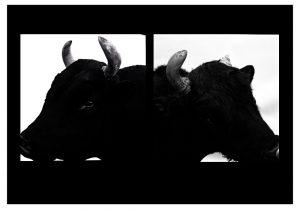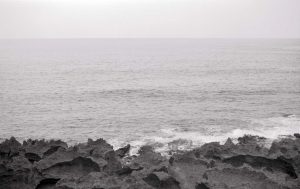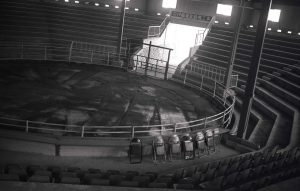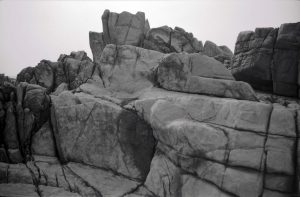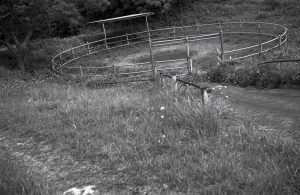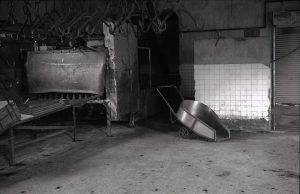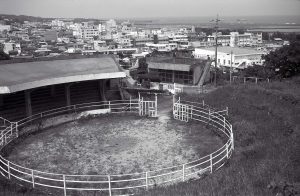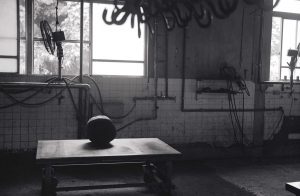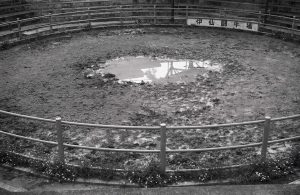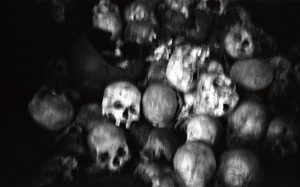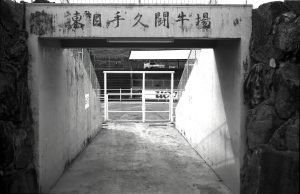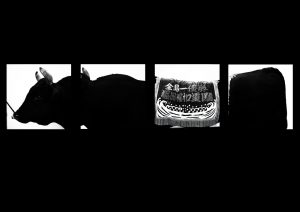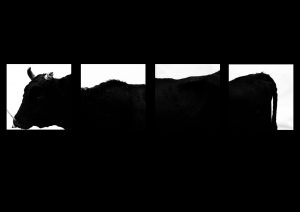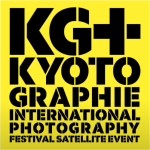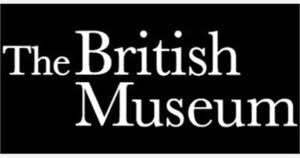MIDSUMMER DEATH
真夏の死
Midsummer Death
Tsunaki Kuwashima
We could hardly recognize him.
Is he dead?
I saw him after he has gone.
I had no words to exchange with him.
He might have sensed it or he might try to avert unnecessary tragedy by having a strain conversation,
he opened the pupil and lure me into the darkness.
His image reminded me of the vermilion inside of him.
That was bubbling and boiling like magma.
He bled for honor.
He could have given up anytime.
He lived with the sun and died in mid-summer.
I looked up the sky that burnt him away.
May the blood he bled make a way out of no way.
And someone follows in the footstep of him someday.
真夏の死
彼は変わり果てていた。
やはり死んでいるんだろうか。
僕は、逝ってしまった彼に会った。
彼と交わす言葉を僕はもう持ち合わせてはいない。
それを感じとってか、
もしくは不細工な会話による悲劇を避ける為なのか、
彼は大きな瞳を開き、
その漆黒の中へと僕を誘った。
彼はその内にかつて滾らせたマグマのような朱を
己の名誉のために流してきたことを僕に思い出させた。
彼は何時でも辞めることが出来たはずなのに。
彼は太陽と生きて真夏に死んだ。
僕は彼を堕とした空にすがった。
彼が流してきたものが道を作り、
いずれその道を歩む者が現れますようにと。
桑嶋維
Michael Horsham(TOMATO)
The photographic image is a cypher for a moment, passed and captured. The cypher is the result, or evidence of codification of an act, or rather several acts. The cypher encodes the momentary action of releasing the shutter. Releasing the shutter: opening it at 1/24th, 1/100th of a second (or whatever length, on whatever film speed) will let light in on a focal plane and fix for near eternity the real and virtual objects inverted on the sensitised plate, pixel sensor field, emulsion or film. This used to be a special moment. This making of the image. Hold it. Flash! Bang! Wallop what a picture! Making a photograph was originally a one off, right up until the invention of the motor drive by Nikon in the 1970’s. But the act of making has been accelerating. In the century and a half of photographic reproduction perhaps the act has become banal, or at least so easy to iterate that it has ceased to become special. The more the means of “photographic” reproduction proliferates, the more we have access to the edited high lights of everyone with a smartphone. The cypher/image is now an instantly sharable codification of the moment. Arguably the democratisation of photography in this way is a good thing. It means that we are becoming (in the developed world at least) a more visually aware culture. On the other hand, the relentless adding to the compost of code, piling up in the server farms of the world as a result of the world’s image sharing obsession might also be evidence that everyone thinks they are image makers. But the deft use of Instagram’s filters or Flickr’s frames does not a photographer make. When you come across a photographer, out there in the world, making images, you sort of know it.
The image base, the approach of a photographer is distilled from a different impetus, a different set of desires. It’s not necessarily about creating the evidence of having seen a sunset, bought shoes or ordered the perfect brunch. No. Photographers who are actually photographers, tell stories through the images they make and tell them continuously. The codification of their acts of framing lighting and shutter release create a continuum of story telling, frame by frame, place by place, subject by subject. The eye of the photographer is key. If this little discourse works, it brings us neatly to the work of Tsunaki Kuwashima. The perfectly compelling images of the dogu – votive figures made in the the Jomon period which stretches back to 14,000 years BC – have within them a story element that might be impenetrable, mute and mysterious. These images raise questions in the mind in ways that most do not. This is portraiture of objects. Printing techniques and framing techniques aside, there is continuity in the approach and the atmosphere generated by these odd and essentially Japanese things. There is an obsession with Japanese things here. The series Togyu-tou Tokunoshima (The Island of Bullfighting, Tokunoshima) is also portraiture, but documentary portraiture. The fighting bulls of the little islands carry meaning and history in their scars, posture and musculature. They are representative of a culture that is historically, geographically and culturally Japanese – but beyond that they speak of a time when our human structures of communication and communion were simpler, more direct and arguably more powerful. The fascination with the symbology of human activity continues through the images of cock and dog fighting.
Repellent to some though these images, and the activities they represent, may be, the documentation of these activities reveal an anthropological fascination on Tsunaki’s part with just how we communicate with each other via means that are becoming increasingly rare. To see, capture document and tell those stories is the function of the photographer. To do it in a way that is visually compelling, arresting and at times beautifully is the role of the artist. Tsunaki Kuwashima successfully combines the two roles.
Michael Horsham is a Partner in the art and design collective Tomato. Tomato has been in existence for over twenty years and in that time as part of the studio Michael has published books, made installations, created commercials and campaigns for a wide range of clients from the BBC to the Okinawa Government, curated exhibitions and designed artworks and products and made music and digital media. Michael also teaches at the Royal College of Art and is always interested in the possibilities of new collaborations.
マイケル・ホーシャム
Michael Horsham(TOMATO)
アーティスト
写真とは、過ぎ去る一瞬をとらえるサイファーである。サイファーとは、一つの行為あるいはいくつかの行為を目に見える形にしたという結果、ないしは証拠である。サイファーとは、シャッターを切るという一瞬の行為を別の形に変換するものである。シャッターを切るということ、すなわちそれはシャッターを1/24秒、1/100秒(または長さやフィルムスピードがどのくらいであっても)開くことによって、焦平面に光を入れ、ときに本物だったり、ときにバーチャルだったりする被写体を感光板、イメージセンサー、乳剤やフィルムに転化し、半永久的に留めることである。かつてこれは特別な瞬間であった。画像を作るということ。構えて、フラッシュ!ボン! バシャ!見事な写真だ! ニコンが1970年代にモータードライブを開発して高速連写が可能になるまで、写真を作ることはもともと一度限りの事であった。しかし作る行為は加速し続けている。1世紀半の写真撮影の歴史の中で、おそらくその行為は平凡なものになってしまったように思う。少なくとも、あまりに簡単に何度も繰り返すことができるので、それは特別なものではなくなってしまった。「写真」撮影の手段が増殖することは、スマートフォンを持つ全員の選りすぐったハイライトの場面を見せられる機会が増えることを意味する。いまやサイファー/画像は、瞬間を手軽に共有できるコード、ないし成文化なのである。
議論の余地はあるかもしれないが、このような写真の大衆化というのは良いことだ。つまり我々は(少なくとも先進国では)視覚的な理解度の高い文化になってきているのだ。しかしその一方で、これでもかとコードという名の肥料が継ぎ足され、世界中のサーバーという名の畑に積み上げられている。この世界が画像共有に取りつかれた結果であり、誰もが皆イメージメーカーであると思っていることの証なのかもしれない。しかし、インスタグラムのフィルターやフリッカーのフレームを器用に使いこなすことで写真家になれるわけではない。写真家と聞いて思い浮かべるのは、世界のどこかに旅しイメージを作る人、そんなところではないだろうか。イメージの基礎となるもの、すなわち写真家のアプローチとは、普通と違う衝動や欲求などが抽出されて出来上がるものである。夕日を見たとか、靴を買ったとか、ブランチのオーダーが完璧だったとかの証拠として写真があるわけではない。否。自らのイメージを通して物語を伝え続けるのが本当の写真家であるはずだ。
フレーミング、ライティング、シャッターを切ると言った行為を目に見えるものにすることは、一コマ一コマ、その場所その場所、そのモノそのモノの連続した物語を作り上げることである。写真家の目こそが鍵である。このミニ講義を理解してもらえると、桑嶋維の作品の世界に近づくことができる。非常に人目を惹く土偶(始まりが紀元前14000年前まで遡る縄文時代に奉納された人形)の写真は、奥深く静寂で神秘的な物語を内に秘めている。これらの写真を見る時さまざまな問いが心に生まれてくる。それはほかの写真を見ている時には起こらないことである。これは物を肖像画のように撮影した写真である。印刷技術やフレーミング技術はさておき、この奇妙で極めて日本的な物が醸し出す雰囲気とアプローチには連続性がある。ここには日本のモノへの強いこだわりがある。闘牛島・徳之島のシリーズもまたポートレートであるが、こちらはドキュメンタリーポートレートである。この小さな島の闘牛たちは、その傷、体つき、筋肉で歴史を物語る。歴史的にも地理的にも文化的にも日本を代表するものではあるが、それ以上に人間のコミュニケーションやコミュニティがもっとシンプルで直接的で多分もっとパワフルだった時代を伝えてくれるものである。これら闘鶏や闘鶏の写真を通して人間の活動の象徴への興味が続いていくのである。
幾つかの写真やその写真が伝える活動は見るのが辛くなるようなものである。けれど、この活動のドキュメンタリー写真を通して、桑嶋 は我々が急速に珍しくなりつつある手段を使ってお互いどのようにコミュニケーションをとるものなのかという彼の人類学的な興味を表現しているのかもしれない。見て、事実を捉え、それを伝えることは写真家としての役目である。それを人を惹きつけられずにはいられないようなビジュアルで時には美しく見せるのはアーティストの役目である。そのふたつを両立しているのが桑嶋維なのだ。
マイケル・ホーシャム/Michael Horsham
イギリス生まれ。 アートデザイン集団 TOMATOのパートナー。TOMATOは1991年に設立以降イギリスにとどまらず国際的にもメジャーなクリエイティブ機関である。1994年から現在に至り、書籍デザイン、芸術インスタレーション及びコマーシャルやキャンペーンなど数多くの制作に関わってきた。クライアントはイギリス放送局(BBC)や沖縄県政府など。メデイア範囲も広く、アート、プロダクトデザイン、音楽やデジタルメデイア制作にも関わってきた。現在英ロイヤル・カレッジ・オブ・アートで講師を務めると同時に新たなコラボ企画にも興味を寄せる。
Tsunaki Kuwashima is a unique breed among photographers. His intimate portraits of dogs, cocks and bulls―all used for fighting―capture the purity of life before the eruption of violence. Over the years, Kuwashima has followed the lives of the animals and their caretakers and the communities who still breed these indigenous creatures in small parts of Japan following the age-old tradition of animal fighting that dates back for centuries. The animals are revered and respected, and the fights are held under strict rules with honor rather than money at stake. As contradictory as this may sound, these fighting animals are in the majority of cases looked after with utmost pride and care as though they descend from a higher order.
While many humans including the Japanese condemn such cruel acts against animals and detest humans who derive pleasure from inflicting pain and suffering on sentient beings, Kuwashima confronts the issue head on by photographing some of the most intimate portraits of the battle-hardened animals. He uses his photography as an act of intervention. “I photograph them to record the tradition so that it may go extinct. My images are historic records so that people can abandon animal fighting practices knowing that its long history has been preserved safely in my images.” With these thoughts, he documents and preserves a tradition through his lens that to many has no place in contemporary [life/ways of thinking].
The focus of this exhibition is on the extraordinary rise and demise of one of the most successful fighting bulls, Fukuda Kiwamichi I (1995-2010). Considered to be the strongest in Tokunoshima island’s bull fighting history, Kiwamichi I’s glory is eternalised through Kuwashima’s lens. The bull was for many years the pride of Tokunoshima, a tiny island that sits some 500 km south of the southern tip of Japan that Kuwashima calls the ‘Bullfight Island’. The bull fighting tradition here and the surrounding Amami region has a history of some 400 years dating back to the time when the area was under the control of the powerful Satsuma clan. Tokunoshima in particular has been renowned for its strong bulls and the dedication and respect its people give to them.
Through a series of large-scale collotype prints, the images of Kiwamichi I in his prime fighting years and his later years long after leaving the ring, the transience of life and worldly successes are eternalized. The prints are the largest of their kind – each measuring 120 x 120 cm and together spanning five meters across – ever to be produced by Benrido Contemporary Collotype Atelier in Kyoto, an esteemed art print specialist. The result is a dynamic photographic installation.
Kazz Morohashi is a Japanese-American and British-American who grew up in the United States. After receiving an MA in Art History from the School of Oriental and African Studies in London, she worked at the Sainsbury Institute for the Study of Japanese Arts and Cultures, where she was involved in a number of projects related to the study and international promotion of Japanese art and culture. He is currently involved in his own production activities and curation, and is involved in projects from South Africa to Japan and the UK. He is also active in creative networking and has high expectations for new encounters and exchanges in the future, both domestically and internationally.
美術家
桑嶋維は、写真家の中でもユニークな部類だ。彼が写す犬、鶏、牛はすべて格闘用であり、その写真は暴力が起こる前の命の純粋さを捉えたものである。何年にも渡り、桑嶋はこうした動物とそれを世話する人々の生活、そしてその地域の人々を追っている。いまだ日本のごく限られた小さな地域では、何世紀にもわたる古い伝統に従って、動物を戦わすためにこうした地域性の濃い生き物が繁殖され育てられているのである。この動物たちは大変尊ばれており、格闘は厳格なルールのもとで、お金のためより名誉のために行われている。矛盾して聞こえるかもしれないが、これらの格闘用の動物は多くの場合、天からの授かりもののように大切に、そして高い誇りをもって飼育されているのである。日本人を含む多くの人々が、動物に対してそのような残酷な行いをすることを非難し、痛みを感じる生き物を苦しめることに喜びを見出すような者を嫌悪する一方、桑嶋は激しく戦う動物たちに肉迫するポートレイトを撮影することでこの問題に正面から立ち向かっている。彼は自分の写真を動物虐待防止の手段として用いているのである。「私はこの伝統の記録を残すために写真を撮っています。それが絶滅してもいいように。私の写真は歴史の記録なのです。私の作品の中にその長い伝統が保存されていることを知れば、人々は動物を戦わせることをやめることができるかもしれません。」このような考えのもと、桑嶋は現代的な生活や思考の中では居場所がない多く伝統に対して、彼自身のレンズを通して記録し保存しているのである。この写真展は、もっとも輝かしい成績を収めた闘牛、福田喜和道一号の桁違いの隆盛とその終焉に焦点を当てている。徳之島の闘牛の歴史の中でも最強とされる喜和道一号の栄光は桑嶋のレンズにより永遠となった。喜和道一号は長い間、徳之島の誇りだった。この日本の最南端から500kmのところに浮かぶ小さな島を桑嶋は「闘牛島」と呼ぶ。この島と奄美諸島での闘牛の歴史は強力な薩摩藩により統治されていた400年前に遡る。とりわけ徳之島は闘牛と人々の生き方が濃く混じりあう特異な島として知られている。大判コロタイプによるこの連作において、最盛期と引退後を写した喜和道一号の姿は、その生の儚さと闘牛としての成功とを永遠に留めておくものになっている。プリントは美術印刷の専門家である便利堂コロタイプ工房において、これまで作成されたコロタイプ写真の中でも最も大きい120×120cmになっており、全長5メートルもの圧倒的迫力をもつ写真彫刻に仕上がっている。
アメリカ育ちの日系アメリカ兼イギリス人。英ロンドン東洋アフリカ研究学院にて美術史修士 を取得後、英セインズベリー日本藝術研究所で数々の日本美術と文化の研究と国際的発信・促進に関するプロジェクトに関わる。現在は独自の制作活動やキュレーションも行い、企画は南アフリカから日本やイギリスをベースにした プロジェクトに関わっている。クリエイティブのネットワークづくりにも積極的で、国内外問わず今後も新たな出会いと交流に大きな期待を寄せる。
Contribution:Fujio Mukoyama
The South Alps City art museum director
(Former Yamanashi Prefectural art museum arts section director)
The recommendatory letter(translated)
Tsunaki Kuwashima is one of the photographers whom I want to pay attention to most at the collection of photographs “bullfighting island, Tokunoshima” and “Shuan” ,”Yamanashi” (All store up the British Museum, Victoria & Albert Museum).in a series of an essay or a private exhibition, [ push and ] As a writer I would like to observe the photograph art circles in Japan most now when it is trying to clear a new ground level, piercing through a look beyond a lens. It was held by the gallery of Yamanashi Prefectural Museum of Art in 2000 that I met with his work for the first time, A fierce black large cow seizes on an angle after the homecoming result announcement exhibition [Air Hole 2000] focus on the portrait work of London. The photograph collection in 2006 on the theme of the traditional culture “bullfighting” of suiting Kagoshima Tokunoshima is announced, and it’s created a sensation and an echo is called. Above all, as a matter of course, obedient everyday sensitivity such as gentleness and the calmness of islanders gathering in the bullring to- gether, and, as for what is particularly impressive, in intense documentary which I smell of the blood called “bullfighting”, two sensitivity to disagree with is expressed in one piece of work wonderfully.
As he is saying in many magazines “I think that a photograph is present-day ukiyoe” on regular basis It is said “What photograph expression is”, standing face to face against an object with the belief of liking to leave many at least
one masterpiece which can remain in a time. The energy of the earnest work posture and the young writer who try to open a new ground level is felt. By this exhibition, it is stored up in 2010 by SAINSBURY INSTITUTE For the study of Japanese arts and cultures and the British Museum,him who got evaluation high after that to a standard, it is in from an analog to a present-day digital photograph anew about the print technique of the collection “Kuon/The eternal idles” (platinum, P, and print) of masterpieces. By reviewing all based on the history of a photograph, alternative prints, ink-jet photographs, and animation works are made intermingled especially — strong idea that he would like to establish new self-expression again by the exhibiting method etc. which “The optical box / The lights in a cube“, and he call It has. The hot work energy to his young sensitivity and his photograph by obtaining the opportunity of this work exhibition anew, Let Tsunaki Kuwashima be a “Grant applicant”, having an infinite hope for the result so that a stone can invest in the art circles in near future Japan as a new photograph expression. I recommend Tsunaki Kuwashima.
向山 富士雄
南アルプス市立美術館 館長(元山梨県立美術館 学芸課長)
桑嶋 維(つなき)は、2005年以降から写真集『闘牛島・徳之島』『朱殷』(いずれも大英博物館、 ヴィクトリア&アルヴ ァート美術館収蔵) 『山梨』の出版をはじめ、エッセイの連載や個展をとおして、作家としての 視線をレンズの向こう に貫きながら、日本の写真美術界に新たな地平を切り開こうとしている、現在もっとも注目したい 写真家の一人であ る。 私が彼の作品にはじめて出会ったのは、2000年に山梨県立美術館のギャラリーで開催された、 ロンドンのポート レート作品を中心とした帰国成果発表展[Air Hole 2000]以降は、猛々しい黒い大牛が角を突き 合う、鹿児島県徳之島の 伝統文化“闘牛”をテーマにした2006年の写真集を発表し反響を呼ぶ。 中でも特に印象的なのは、“闘牛”という血の臭う ような激しいドキュメンタリズムは当然ながら、 闘牛場に集う島民達の優しさや穏やかさといった素直な日常の感性 が同居し、相反する二つの感性が一枚の作品に 見事に表現されている。 常日頃から「僕は、写真とは現代の浮世絵だ と思うのです。」と多くの雑誌の中で彼が語っているように、 時代に残りうる傑作を一点でも多く残したいという信 念で対象と対峙しながら「写真表現とはなにか」という 新しい地平を開こうとする、真摯な制作姿勢と若い作家のエ ネルギーを感じるのである。 今回の作品展では、セインズベリー日本芸術研究所や大英博物館に2010年に収蔵され、 その後高い評価を得た彼の 代表作品集『久遠』(プラチナ・P・プリント)の印画技法を基軸に、あらためてアナログか ら現代のデジタル写真までを 写真史を元にすべて洗い直すことで、特にオルタネイティブ・プリントやインク・ジェッ ト写真、動画作品らを混在させ、 また、「光箱(キューブ)/The lights in a cube」と彼が呼ぶ展示法などにより、 新たな自己表現を確立したいとの強い考えを もっている。 あらためて、彼の若い感性と写真への熱い制作エネルギーが、今回の作品展の機会をいただくことで、近い将来日本の 美術界に新たな写真表現として一石が投じられるよう,その成果に限りない期待を寄せながら、桑嶋維を推薦します。

